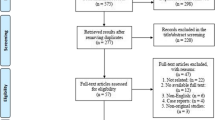Abstract
The purpose is to evaluate white matter (WM) abnormalities in Wilson’s disease (WD) using the technique of diffusion tensor imaging (DTI). The prospective case–control study comprised of 15 drug-naïve patients with WD and 15 controls. The phenotype of subjects was evaluated. The DTI/conventional MRI was acquired (3T MRI): Fractional anisotropy (FA) and mean diffusivity (MD) values were extracted from regions of interest placed in pons, midbrain, bilateral frontal and occipital cerebral white matter, bilateral internal capsules (IC), middle cerebellar peduncles (MCP) and corpus callosum (CC). Six patients showed lobar WM signal changes on T2-Weighted (T2W)/Fluid attenuation inversion recovery (FLAIR) images while remaining had normal appearing WM. MD was significantly increased in the lobar WM, bilateral IC and midbrain of WD patients. FA was decreased in the frontal and occipital WM, bilateral IC, midbrain and pons. Normal-appearing white matter on FLAIR images showed significantly increased MD and decreased FA values in both frontal and occipital lobar WM and IC compared with those in controls. Correlation of clinical scores and DTI metrics revealed positive correlation between neurological symptom score (NSS) and MD of anterior limb of right internal capsule, Chu stage and MD of frontal and occipital WM. Negative correlation was observed between the Modified Schwab and England Activities of Daily Living (MSEADL) score and MD of bilateral frontal and occipital WM and IC. This is the probably the first study to reveal widespread alterations in WM by DTI metrics in drug naïve WD. DTI analysis revealed lobar WM abnormalities which is less frequently noted on conventional MRI and suggests widespread WM abnormalities in WD. It may be valuable in assessing the true extent of involvement and therefore the severity of the illness.


Similar content being viewed by others
References
Acosta-Cabronero J, Williams GB, Pengas G, Nestor PJ (2010) Absolute diffusivities define the landscape of white matter degeneration in Alzheimer’s disease. Brain 133(2):529–539
Ala A, Walker AP, Ashkan K, Dooley JS, Schilsky ML (2007) Wilson’s disease. Lancet 369(9559):397–408
Brewer GJ, Fink JK, Hedera P (1999) Diagnosis and treatment of Wilson’s disease. Semin Neurol 19(261–270):4
Chu NS (1986) Sensory evoked potentials in Wilson’s disease. Brain 109:491–501
Favrole P, Chabriat JP, Guichard F, Woimant F (2006) Clinical correlates of cerebral water diffusion in Wilson disease. Neurology 66:384–389
Finlayson MH, Superville B (1981) Distribution of cerebral lesions in acquired hepatocerebral degeneration. Brain 104:79–95
Gitlin JD (2003) Wilson’s disease. Gastroenterology 125(6):1868–1877
Hegde S, Sinha S, Rao SL, Taly AB, Vasudev MK (2010) Cognitive profile and structural findings in Wilson’s disease: a neuropsychological and MRI-based study. Neurol India 58(5):708–713
Kawamura N, Ohyagi Y, Kawajiri M, Yoshiura T, Mihara F, Furuya H, Kira J (2004) Serial diffusion-weighted MRI in a case of Wilson’s disease with acute onset hemichorea. J Neurol 251(11):1413–1414
Kishibayashi J, Segawa F, Kamada K, Sunohara N (1993) Study of diffusion weighted magnetic resonance imaging in Wilson’s disease. Rinsho Shinkeigaku 33(10):1086–1089
Kumar R, Gupta RK, Elderkin-Thompson V, Huda A, Sayre J, Kirsch C, Guze B, Han S, Thomas MA (2008) Voxel-based diffusion tensor magnetic resonance imaging evaluation of low-grade hepatic encephalopathy. J Magn Reson Imaging 27(5):1061–1068
Lucato LT, Otaduy MC, Barbosa ER, Machado AA, McKinney A, Bacheschi LA, Scaff M, Cerri GG, Leite CC (2005) Proton MR spectroscopy in Wilson disease: analysis of 36 cases. AJNR Am J Neuroradiol 26(5):1066–1071
Magalhaes AC, Caramelli P, Menezes JR, Lo LS, Bacheschi LA, Barbosa ER (1994) WD: MRI with clinical correlation. Neuroradiology 36(2):97–100
Meenakashi-Sundaram S, Taly AB, Kamat V, Arunodaya GR, Rao S, Swamy HS (2002) Autonomic dysfunction in Wilson's disease - A clinical and electrophysiological study. Clin Auton Res 12:185–189
Meenakshi-Sundaram S, Mahadevan A, Taly AB, Arunodaya GR, Swamy HS, Shankar SK (2008) Wilson’s disease: a clinico-neuropathological autopsy study. J Clin Neurosci 15(4):409–417
Prashanth LK, Sinha S, Taly AB, Mahadevan A, Vasudev MK, Shankar SK (2010) Spectrum of epilepsy in Wilson’s disease with Electroencephalographic, MR imaging and pathological correlates. J Neurol Sci 291:44–51
Schlaug G, Hefter H, Engelbrecht V, Kuwert T, Arnold S, Stöcklin G, Seitz RJ (1996) Neurological impairment and recovery in Wilson’s disease: evidence from PET and MRI. J Neurol Sci 136(1–2):129–139
Schwab R, England A (1960) Projection technique for evaluating surgery in Parkinson’s disease. In: Gillingham F, Donaldson I (eds) Theme symposium on Parkinson’s disease. E&S Livingston, London
Sener RN (2003a) Diffusion MR imaging changes associated with Wilson disease. AJNR Am J Neuroradiol 24(5):965–967
Sener RN (2003b) Diffusion MRI findings in Wilson’s disease. Comput Med Imaging Graph 27(1):17–21
Seniów J, Bak T, Gajda J, Poniatowska R, Czlonkowska A (2002) Cognitive functioning in neurologically symptomatic and asymptomatic forms of Wilson’s disease. Mov Disord 17(5):1077–1083
Sinha S, Taly AB, Ravishankar S, Prashanth LK, Venugopal KS, Arunodaya GR, Vasudev MK, Swamy HS (2006) Wilson’s disease: cranial MRI observations and clinical correlation. Neuroradiology 48(9):613–621
Sinha S, Taly AB, Prashanth LK, Ravishankar S, Arunodaya GR, Vasudev MK (2007) Sequential MRI changes in Wilson’s disease with de-coppering therapy: a study of 50 patients. Br J Radiol 80(957):744–749
Starosta-Rubeinstein, Young AB, Kluin K, Hill G, Aisen AM, Gabrielsen T (1987) Clinical assessment of 31 patients with WD. Correlations with structural changes on MRI. Arch Neurol 44:365–370
Tarnacka B, Szeszkowski W, Buettner J, Gołebiowski M, Gromadzka G, Członkowska A (2009) Heterozygous carriers for Wilson’s disease–magnetic spectroscopy changes in the brain. Metab Brain Dis 24(3):463–468
Conflict of interest
None
Financial Disclosures
None
Author information
Authors and Affiliations
Corresponding author
Rights and permissions
About this article
Cite this article
Jadav, R., Saini, J., Sinha, S. et al. Diffusion Tensor Imaging (DTI) and its clinical correlates in drug naïve Wilson’s disease. Metab Brain Dis 28, 455–462 (2013). https://doi.org/10.1007/s11011-013-9407-1
Received:
Accepted:
Published:
Issue Date:
DOI: https://doi.org/10.1007/s11011-013-9407-1




